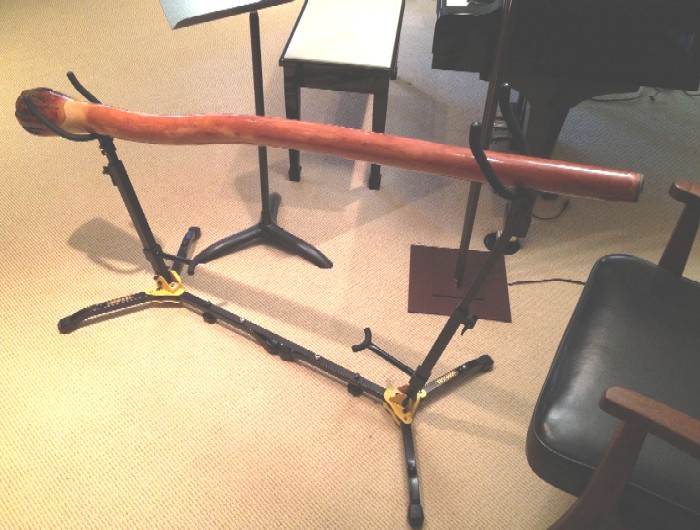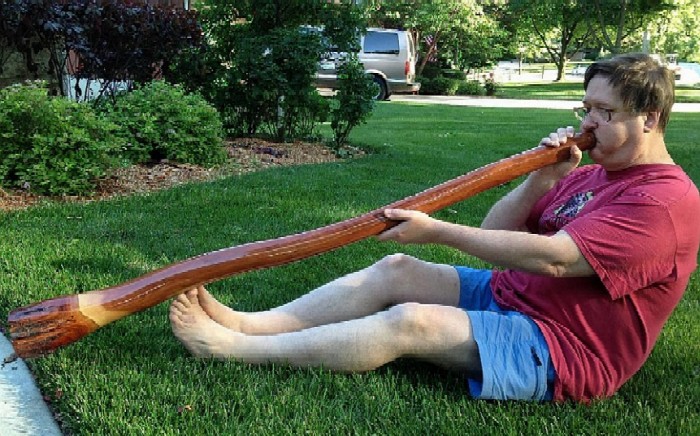T here are a few orchestral works that include didgeridoo (Sean O’Boyle and others), but for conservatory recital or chamber performances there are currently only about 3 dozen chamber music compositions that are readily available. Most of these are indexed at the Australian Music Centre (Duos, Quartets, Quintets, Sextets, Octets; Solo with vocal ensemble). You may also want to consider Peter Sculthorpe’s String Quartet No. 12 with didjeridu, and ‘Lorin’s Piece’ for didjeridu and voice; Neal Corwell’s ‘Aboriginal Voices’ trio for tuba, didgeridoo, and voices; Philip Glass’s ‘Voices’ for organ, didgeridoo, and narrator; and Dubravko Lapaine’s ‘Rescribi’ trio for piano, didgeridoo, and percussion.
[50-sec clip, Dubravko Lapaine, ‘Kosmopterix’, ‘Rescribi’, 1.6MB MP3]
and ‘Putnik’:
[50-sec clip, Dubravko Lapaine, ‘Kosmopterix’, ‘Putnik’, 1.6MB MP3]
T he aboriginal people have a great deal to teach the western world about wind playing in general and lip reeds in particular. The trombone may seem old when compared to western orchestral instruments, but it is only a five hundred year-old baby when compared to the possible forty thousand-year-old tradition of the didjeridu.”
— Stuart Dempster, 1979.
V irtuosic double- and triple-tonguing in the didgeridoo repertoire have parallels to ‘cursus’ in classical Latin oratory and medieval chant (see Eklund, link below), and you might consider that idea in preparing a program. Rhythm—the patterning of accents in speech or singing—establishes expectations; it entrains the listener and the speaker, phase-locking them to the pattern. Accents in Latin fall on at least one out of every three syllables. But in English and other languages the gaps are longer—you can often go for five or six syllables between accents. The didge literature tends to emphasize prosody and oratorical aspects—not only because of your vocalizations into the didge, but also because you have just the fundamental (and pedal), plus a few harmonics (‘toots’, ‘trumpets’) to work with. (Years ago, Juilliard professor Ivan Galamanian famously drew an analogy between instrumental (violin) playing and speech, in which he asserted that attacks are consonants and the sustained notes are vowels, and performers should treat them as such. The analogy is true enough for strings and other instruments, but it’s hardly even an ‘analogy’ in didgeridoo playing: given all of the tongue, jaw, and vocal tract technic involved in didge performance, the vowels-consonants assertion is a self-evident fact of how the didge sounds are produced.)
V ocal and instrumental rhythms are sometimes direct translations of a poetic meter. In other words they may be sung or played, interchangeably. Far more often than not, however, vocal and instrumental rhythms create what we might call ‘rhythmic counterpoint’ when heard with reference to the poetic meter—the interplay among two or more rhythmic threads or voices. By continually altering the durational relationships and varieties of accent in a succession of syllables, musicians can elicit the close attention of listeners.”
— Michael Tenzer, p. 43.
I n thinking about other instrumental repertoire that might be suitable as-is or transcribable for chamber didge recital, you might explore pieces whose articulation and accents entail sound-envelopes that are marcato ‘thrust-followed-by-decay’, an accent that resembles a plucked string instrument like a double-bass. With the didge, the decay is because the outflow of air from the cheeks that occurs while you are inhaling through the nose in circular breathing can’t be as forceful or sustained as the outflow of air when supported by the diaphragm. In general, highly rhythmic, marcato pieces in low register are likely to be feasible and stylistically coherent with didge performance practice, regardless whether they are for winds, strings, or percussion. There are pieces for tympani (for example, Daniel Jenkyn Jone’s ‘Sonata for Unaccompanied Kettledrums’) that could be performed as-is or transcribed for didgeridoo. And there are a number of chamber pieces for bass clarinet or low brass that are plausible. More links that you may find useful follow.

- Lapaine D. Kosmopterix. (Didgiland, 2009.)
- Dubravko Lapaine website
- Duende Didgeridoo online shop (Lapaine-built instruments)
- World of Music Awards (WoMA)
- Aboriginal Art Galleries (didges), 2 East Circular Quay, Sydney NSW
- Agawu K. Music as Discourse. Oxford Univ, 2008.
- Carruthers M, ed. Rhetoric beyond Words: Delight and Persuasion in the Arts of the Middle Ages. Cambridge Univ, 2010.
- Dempster S. The Modern Trombone: A Definition of its Idioms. Univ California, 1979.
- Edwards J, Lampert M, eds. Talking Data: Transcription and Coding in Discourse Research. Psych Press, 1993.
- Eklund S. The use and abuse of cursus in textual criticism. ALMA 1984; 43:27-56. [15MB pdf]
- Galamanian I. Principles of Violin Playing & Teaching. Shar, 1999.
- Godøy R, Leman M, eds. Musical Gestures: Sound, Movement, and Meaning. Routledge, 2009.
- Hiley D. Western Plainchant. Oxford Univ, 1995.
- Landman H. Poetry ‘feet’ and computer science. Polyamory, 24-MAY-2001.
- Michael V. Didgeridoo Method. Mel Bay, 2006.
- Nattiez J-J. Music and Discourse. Princeton Univ, 1990.
- Neuenfeldt K, ed. Didjeridu: From Arnhem Land to Internet. Libbey, 1999.
- Puhan M, et al. Didgeridoo playing as alternative treatment for obstructive sleep apnoea syndrome: randomised controlled trial. BMJ 2006;332:266-70.
- Salvo V. 240 Double- and Triple-Tonguing Exercises. Alfred, 1985.
- Schiffrin D, Tannen D, Hamilton H, eds. Handbook of Discourse Analysis. Wiley-Blackwell, 2003.
- Som C. Milkayngu Mununggurr: Hard-tongue didgeridoo, white paper at SeriousSticks.com
- Tenzer M. Analytical Studies in World Music. Oxford Univ, 2006.
- Welch C. Appropriating the didjeridu and the sweat lodge: J Contemp Religion 2002;17:21-38.
- Wennerstrom A. The Music of Everyday Speech: Prosody and Discourse Analysis. Oxford Univ, 2001.
- Ondrej Smeykal website
- Tonguing page at Wikipedia
- Didgeridoo tonguing page
- iDidj forums
- Hercules® Bari sax stand (Musicians’ Friend) [a pair of these stands set up in-line with each other works pretty well for holding a heavy didge on-stage, performing either seated or standing; see jpeg above]
- Hercules® Bari sax stand (Hercules)
- Meinl didge gig bag, 58-inch (Musicians’ Friend)
- Meinl Percussion didge gig bag, 58-inch (Meinl)
- DidgeridooStore didge gig bag, 62-inch


No comments:
Post a Comment